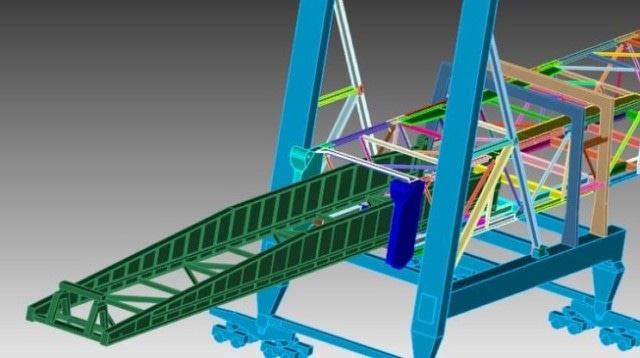Jun 1 2016
A new software program has been designed to reduce the time taken to detect weak points in large structures such as bridges, cranes, oil platforms, and mining equipment from a number of days to several minutes. This novel program, created by Akselos a company based at EPFL’s Innovation Park, integrates 3D and 1D elements, and is more dependable than the traditional technique. It is also capable of accomplishing all of this with accuracy and unparalleled speed.
 1D/3D simulation with Akselos software © 2016 Akselos
1D/3D simulation with Akselos software © 2016 Akselos
A few days faster
To give an example, it took 8 minutes and 20 seconds for our software to solve 100 load combinations on a shiploader model that has over 5 million degrees of freedom, versus more than 3 days with the conventional method.
Thomas Leurent, CEO of Akselos
This novel and highly anticipated technology combines the need for 3D simulation and the speed of 1D beam elements. 3D representations are slow and monotonous, but are completely necessary for consistently testing stress points such as joints.
More accurate simulations
Akselos’ software platform has the potential to be a great advantage to engineers. It is undesirable to go from a 1D workflow to the 3D workflow when large structures such as a mining machine made of 14,000 tons of steel have to be tested. Instead of carrying out a time-consuming 3D simulation of the whole structures, engineers will use a universal 1D model along with 3D sub-models.
However, decoupling the models weakens the dependability of the total outcome. In order to precisely estimate the way a structure will function, engineers need to comprehend the global and comprehensive character of the model since certain problems occurs from the reality that these structures are assembled.
Decoupling is a very optimistic view on engineering. Moving to a completely integrated workflow, engineers would gain time, but more importantly, their models would be less error-prone.
Thomas Leurent, CEO of Akselos
Super-fast calculations
Akselos' innovation is centered on research performed at MIT that was then created in partnership with EPFL labs. It increases certain calculations required for 3D simulations. Now, these are nearly as fast to solve as beam elements.
“Mathematicians have been working on this method since the year 2000, and it was recently marketed by Akselos for industrial applications,” said Marco Picasso, whose lab worked on the software program as a part of the two Commission for Technology and Innovation projects.
The software helps to simplify a complex geometry for which the calculations have been prepared earlier. The elements are subsequently placed back together in record time. At that position, it is simple to apply various loads to the reassembled representation.